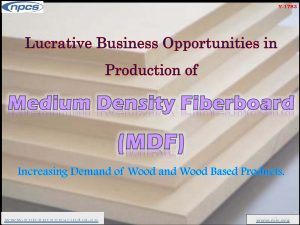Start a Business of Medium-Density Fiberboard (MDF) Production. Investment Opportunities in Wood and Wood-Based Products.

Medium-Density Fiberboard (MDF) is a highly versatile engineered wood product widely used in the furniture and construction industries due to its smooth surface and durability
Related Projects Report: click here for the report
Manufacturers mostly use MDF for interior applications due to its weak moisture resistance. It comes unfinished with a fine sanded surface or with a decorative overlay like wood veneer, melamine paper, or vinyl.
Types of Medium-Density Fiberboard (MDF)
The following are the different types of MDF (which are sometimes classified by colour):
- MDF plate that is extremely light (ULDF)
- Moisture-resistant plywood is usually green in colour.
- MDF that is fire-resistant is usually red or blue.
Start an Industry in Madhya Pradesh, Click Here
Start a Business in Ethiopia, Click Here
Advantages of Medium-Density Fiberboard:
You can drill and slice moderate-density fibreboard without damaging it, as it has no grain. Furthermore, its great density allows you to use equipment on it.
- It is free of kinks and knots and has a smooth surface.
- Unlike actual wood, MDF does not flex or expand as a result of temperature changes. The swelling that happens in MDF as a result of moisture exposure is likewise minor.
Related Books:- click here for more books
- Due to its high density, MDF holds hinges and screws more securely.
- Unlike raw wood, which takes a long time to dye, MDF is simple to stain and colour.
You can easily cut and carve MDF into various designs thanks to its smooth edges.”
“To simulate genuine wood, you can stain or paint the panel.
Start an Industry in Ladakh, Click Here
Start a Business in the Fiji Islands, Click Here
Analysts valued the global medium-density fiberboard (MDF) market at USD 61.3 billion in 2019 and project it to grow at a CAGR of 6.6 percent from 2020 to 2027.
Increased use of MDF in furniture and construction primarily drives this growth, as well as its versatility across a range of building materials.
Related Videos:- Medium-Density Fiberboard production
Global Growth Trends and Regional Dominance in the MDF Market
As a result, expanding product applications in furniture and construction, along with technical breakthroughs and production improvements, are driving rapid growth in the global medium-density fiberboard (MDF) market.
One of the key factors contributing to the global MDF market’s growth is the increasing building and construction industry, particularly in emerging countries.
In 2019, the Asia Pacific dominated the MDF market, accounting for 61.0 percent of the total market share. As a result, the region played a significant role in shaping the global MDF market.
Read Similar Article: Read here
Try our Startup Selector Tool to see if MDF production suits you.
Market Research: – Market Research Report
In the construction industry, increased investment in emerging nations to meet rising residential housing demand is expected to boost MDF panel demand.
The rising usage of recycled wood fibres in MDF production has also helped to propel the medium-density fiberboard industry forward. Moreover, the growing manufacture of environmentally friendly MDF products will provide new market prospects.
As a result, experts expect these reasons to drive demand for medium-density fiberboard in the coming years.
Start an Industry in Jammu and Kashmir, Click Here
Start a Business in Gabon, Click Here
Major Key Players:
- Amazon Wood Pvt. Ltd.
- Aryan Enterprises Pvt. Ltd.
- Asian Pre-Lam Inds. Pvt. Ltd.
- Associate Decor Ltd.
- Bajaj Eco-Tec Products Ltd.
- Best Board Ltd.
- Darshan Boardlam Ltd.
- Divine Board Pvt. Ltd.
For More Details: https://bit.ly/2S4ngSF
Frequently Asked Questions (FAQs)
1. What is Medium Density Fiberboard (MDF)?
Answer:
Medium-density fiberboard (MDF) is an engineered wood product made by combining wood fibers with resin and compressing them into panels. As a result, it offers a smooth surface, consistent density, and excellent versatility, making it well-suited for furniture, cabinetry, and indoor construction applications.
2. What are the main types of MDF available in the market?
Answer:
MDF can be categorized into several types:
- ULDF (Ultra-Light Density Fiberboard) – Lightweight variant used for non-load-bearing applications.
- Moisture-resistant MDF – Typically green in color, suitable for areas with some humidity.
- Fire-retardant MDF – Usually red or blue, designed for safer usage in fire-prone areas.
3. What are the advantages of using MDF over traditional wood?
Answer:
MDF offers several advantages:
- Moreover, its smooth, knot-free surface makes MDF ideal for painting and finishing.
- Additionally, it is easy to cut, carve, and machine without causing splintering.
- Unlike solid wood, it remains stable against temperature changes, with minimal warping or expansion.
- Furthermore, its dense structure allows it to hold screws and hinges firmly.
- More affordable and sustainable compared to solid wood
4. Where is MDF commonly used?
Answer:
MDF is widely used in:
- Common applications of MDF include furniture manufacturing, wall panels, and partitions.
- It is also widely used in kitchen cabinets and wardrobes.
- In addition, MDF is ideal for doors and shelving units.
- Finally, it serves well in decorative moldings and various interior fixtures.
5. Is MDF suitable for outdoor use?
Answer:
Generally, MDF is not suitable for outdoor applications due to its low moisture resistance. However, moisture-resistant MDF may be used in damp environments like bathrooms or kitchens, but not in direct contact with water.





